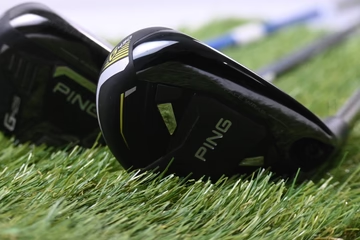Whether it’s an iron, driver, fairway or hybrid shaft you’re looking at, pay close attention to the detail. Start by looking at the shaft band - if it’s counterfeit then the chances are it might be starting to peel up, or perhaps it’s not perfectly straight on the club or in a totally different place than usual. Does the shaft feel flimsy and does the flex not feel as stiff as the shaft states? Take a look at the colours, too - are they lighter or darker than you’d expect, are they in the right place and do any graphics look like they might be in the wrong place?
You might have noticed that a lot of the major brands have been adding a holographic sticker to the shaft of their clubs. Well, fraudsters are doing this too, but they’re often ending up in the wrong place - and often they are tempted to stick it to the shaft band near the top of the shaft so that it’s easy to spot - perhaps to make it look more authentic to the untrained eye. So if there’s a holographic sticker, make sure it’s where it should be.


How to avoid counterfeit clubs (and how to spot genuine ones)
Selling counterfeit golf clubs may be strictly against the law, but that doesn’t stop the unscrupulous from trying anyway. And often they get away with it, that is until a keen-eyed golfer notices what they are up to and reports them. Sometimes, it can be the last person you suspect - in 2019, a professional golf tutor was jailed for 16 months for selling nearly £100k’s worth of fake golfing gear.
Even if you unknowingly sell a counterfeit golf club, you will find yourself on the wrong side of the law, so ignorance is not an excuse. It’s such an issue that the British Golf Industry Association (BIGA) is doing what it can to raise awareness of the risks associated with buying and selling counterfeit golf equipment.
At golfclubs4cash our customers have full faith that we only buy and sell 100% genuine and authentic golf clubs, and we’ve got the glowing reviews to prove it. It may be hard to tell the difference to an untrained eye, but thanks to our years of experience we can spot a fake a mile off. We’re doing our bit to reduce the number of fake golf clubs in circulation, and raising awareness of the problem to stop counterfeit golf club makers in their tracks.
In this handy guide, we’ll share with you loads of top tips gained from our extensive experience in identifying fake golf clubs. Arm yourself with the knowledge you need to avoid getting ripped off with fake goods, and you’ll save yourself a lot of time, hassle and money in the process.
PS. Check out this video for a tour of the golfclubs4cash warehouse, advice on buying and selling used golf clubs, and a little insight into how our experts spot counterfeit golf clubs (you’ll find it at 6 minutes in).
How can I tell if a used golf club is counterfeit or genuine?
If it’s possible to compare the club you are looking at with a genuine one, then this is a great way to tell real from fake. However, that’s not always a viable option, so read on to learn how you can become your own expert when it comes to spotting fake used golf clubs.
If it’s too good to be true, then it probably is.

If it’s too good to be true, then it probably is.
Amateur golfers and people who are new to the game can easily be enticed by a cheap golf club or accessory on platforms such as eBay. It’s important to remember that, as with anything else in life, if it’s cheap then it’s probably for a very good reason.
A low price can be one of the biggest indicators that a golf club is counterfeit, so don’t be fooled into thinking you’re getting yourself a bargain.
Where’s it coming from?

Where’s it coming from?
The majority of the counterfeit golf club manufacturers are based in China, so if you are buying from a supplier that is based there then this should raise alarm bells. Only last year, nearly 10,000 counterfeit golf clubs were found in China, and in 2020 the largest haul of over 120,000 fake golf clubs was seized in raids, again in China, with 15 suspects being arrested and detained. That starts to give you an idea of the scale of the problem. That’s not to say that every golf club manufactured in China is fake of course, but it is certainly worth being alert to the possible risks.
While many of the leading brands may have parts that have been manufactured in China due to the lower factory costs, they tend to assemble all of their clubs in the UK or US.
How to spot a counterfeit grip

How to spot a counterfeit grip
The grip of a club is an excellent first place to start, as there are some common giveaway signs to be found in a fake club here. Firstly, what does it smell like? If there is a very strong rubber-like odour then it could well be a counterfeit.
Take a look at the logo/s on the club - are they aligned properly and are there any areas where they look like they could be peeling off? Is the font slightly different to the real thing? Is the grip itself aligned perfectly to the club, or does it look like it doesn’t quite fit?
How to spot a counterfeit shaft
How to spot a counterfeit head on irons and wedges

How to spot a counterfeit head on irons and wedges
Check the head of your iron or wedge carefully—does it match the rest of your set in shape and quality? Look at the paintwork: is it neat and inside the lines? Inspect the font and logo—thin or off-brand lettering can be a sign of a fake. The ferrule (the black ring above the hosel) is usually shorter on counterfeits. Also, assess the finish: genuine clubs have even grooves and a consistent depth, while fakes might look shinier. Lastly, look for 'bag chatter'—the small dents from use; genuine forged clubs show these, while counterfeits made from cheaper materials often don’t.
How to spot a counterfeit head on drivers, fairways and hybrids
Have a look at the branding and lofts - they can often be in slightly the wrong place or the wrong colour on an inauthentic golf club. The club head itself might be a different shape than you might expect, the face angle could be slightly off and the adjustment adapter might not be lined up accurately. Check out the serial number and compare it to that of a genuine club - is it in the usual size font, or is it bigger or smaller than usual?
Perhaps the biggest clue when it comes to spotting fake drivers, fairways and hybrids is the weight of the head. Counterfeits tend to be heavier because they aren’t made of titanium. Not sure how to test if it’s titanium? Use a magnet! It won’t stick to a titanium golf club, so if the magnet is sticking to your driver then it’s more than likely a fake.
How to spot a counterfeit putter

How to spot a counterfeit putter
When appraising a putter to understand if it’s genuine or not, many of the tips above will still apply. For example, take a look at the fonts and colours and see if they match up with a genuine putter. As we all know, the hallmark of a great putter is in its tiny details, and if the alignment is in any way incorrectly set up then this is probably a fake.
Another thing to look at is the removable weights underneath - they should sit flush with the rest of the putter and if they are protruding then that’s a good indication that you may not be looking at a genuine putter. Run your fingers along the bottom of the putter and you’ll be able to feel the edge of the removable weight. Check out the finish too - what does the milling on the face look like?
What else to look out for
Are knock-offs worth it?
Not only this, but you’ll also find that fake golf clubs have a far shorter lifespan. So it really is a false economy to buy fake golf clubs, for many reasons. And don’t forget, you won’t be able to sell them without finding yourself on the wrong side of the law.
At golfclubs4cash we strongly advise all our customers to avoid counterfeit golf clubs at all costs. By buying genuine equipment you’ll be supporting the golfing community and you’ll be playing safe in the knowledge that you’re using clubs that will elevate your game. You’ll also be supporting the genuine manufacturers and retailers of golf clubs rather than lining the spammers’ pockets.
What can you do to reduce the number of counterfeit golf clubs?
We keep our blog updated with the latest news in golfing, including buying guides, how-to guides and a raft of commentary including the latest advice on avoiding counterfeit golf clubs. Make sure you follow us on Instagram and Twitter to stay up to date with the latest golfing offers and deals.
When you buy preloved golfing equipment through golfclubs4cash, you can do so with the utmost confidence that every single item we stock is guaranteed to be 100% genuine. Nothing gets past our expert eye, so rather than buying through an unknown retailer, it’s always wiser to purchase through a tested supplier.
Check out our extensive range of used golf clubs, equipment and accessories, and get in touch if there’s something in particular you’ve got your heart set on and we’ll do our best to help.
PS. Find out how we rate the condition of the second hand golf clubs that we buy and sell. We add more than 500 items every single day for worldwide delivery, and every item is meticulously checked to guarantee authenticity.









